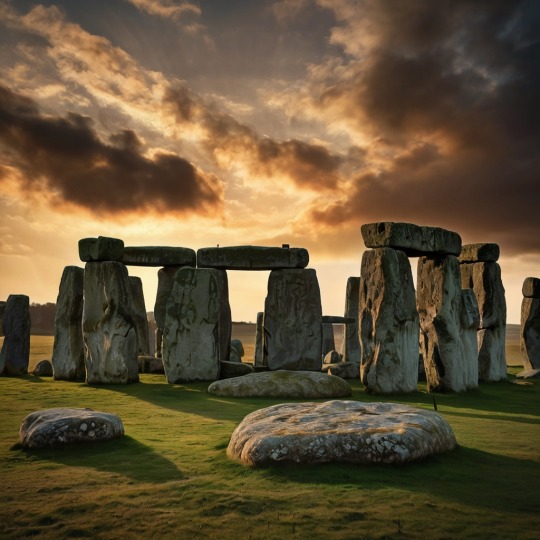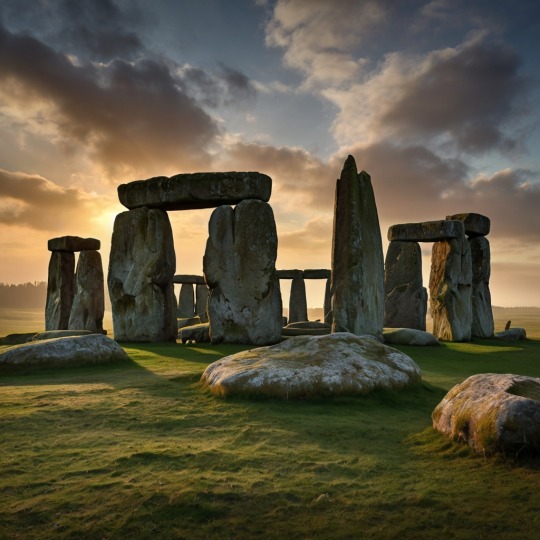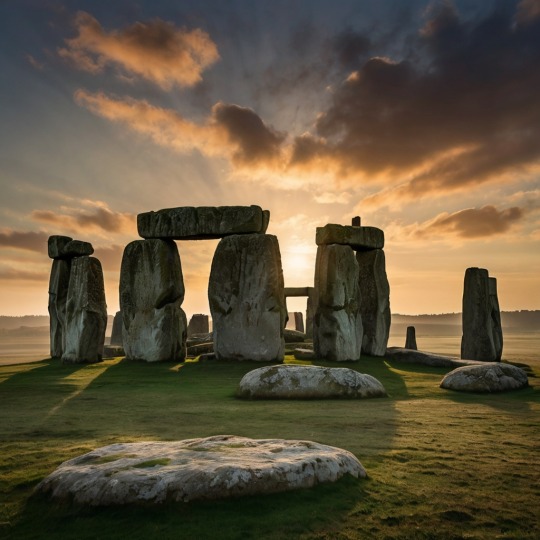#bluestones
Explore tagged Tumblr posts
Text
Stonehenge Mysteries: Men, Mystery, and a Marvel of a Monument

Stonehenge is a megalith organized on the Salisbury Plain in Wiltshire, England, and like all ancient monuments, it has been fascinating for centuries. The construction of the pillars that form the ceiling is thought to be so tall and symbolic that it creates curiosity. Though the available knowledge regarding Stonehenge remains unbiased, several issues are still mired in controversy. This typical blog post focuses on Stonehenge mainly in terms of the purpose of its construction, the methods used in construction, and the celestial purpose that was assigned to the stone circle.
The Purpose of Stonehenge
Arguably, one of the most frequently asked questions about Stonehenge is about the monument’s function. There are a number of theories that, when examined, are proffered with much rationale as to why they should be accepted.

A Ceremonial Site
Due to its construction complexity and its specific layout, Stonehenge was expected to be used ceremonially. This indicates that it was used in religious observances since it has an alignment with the sun solstices of the summers and winters. The main structure of the Heel Stone was placed to align itself with the sun rise on the summer solstice, which suggests solar cult or agricultural rituals.
A Burial Ground
A study carried out on human bones pulled from various digs in and around Stonehenge suggests that it served as the burial place of individuals. Cremated remains were observed at the site, indicating that it was one of the important burial grounds for the elites or people of higher rank in that period and was in use as early as 3000 BC. But this theory fits with the belief that Stonehenge was built as a shrine for ancestor spirits.
A Healing Center
There are theories that certain elements of the monument, as well as the placement of Stonehenge as a whole, were intended to allow for this. A couple of skeletons bearing marks of diseases and wounds that may have been fatal imply that those in ailing states could trek to the shrine with the hope of being healed. The bluestones used in the construction of the circle were believed to have healing virtues, and these originated in Wales.

An Astronomical Observatory
One of the dominant theories is that the grand monument was an ancient observatory, and the stones were aligned with specific stars. This is consistent with the idea since the precise laying down of stones correlates with the occurrence of solstices and equinoxes. It could have probably been utilized in the prediction of astronomy, which helped in agriculture and the scheduling of religious ceremonies.
The Construction of Stonehenge
Historians and archaeologists have marveled at the creation of Stonehenge, which is a circle of stones. No technology was available, and yet it was quite intriguing how the prehistoric people moved and set up those large stones.
Transporting the stones
Stonehenge consists of two types of stones: sarsen stones and bluestones of the neolithic period from western Asia and Europe, respectively. The giant sarsen stones, which each weigh up to 25 tons, may have come from the Marlborough Downs, located 32 kilometers away. These were the smaller bluestones that could weigh up to 4 tons and were transported from Preseli Hills in Wales, more than 240 km away.
Earlier, it was assumed that the construction was transported using sledges and rollers, and later through water bodies. Such an immense operation would have necessitated proper planning in terms of human labor and advanced engineering.

Erecting the Stones
Even when the stones were on site, another problem arose as to how best to put them up or raise them. Currently, ancient writers have posited that prehistoric builders employed a system of earth ramps and wooden beams to lift the construction pieces and maneuver them to their appropriate positions. The lintels, or horizontal stones, were fitted and locked in position through the use of mortise and tenon joints, a sign of the high technicality that had been attained.
Precision and planning
Because there are only megaliths arranged in a circular fashion within the walls of Stonehenge, constructing the monument was a highly precise undertaking that needed careful planning as well as knowledge of geometry and astronomy. They are arranged neatly in a cyclic fashion, and several of them are oriented in specific positions depending on the rightful rites associated with stars. The sophistication of the measurements and the accuracy of the alignments show the builders must have been skilled people with knowledge.
Celestial Alignments
Another interesting historical fact about Stonehenge is that the construction of the circle was to have some kind of correlation with some astronomical phenomena. The feature has had people believing that it was used for astronomical purposes since it was created.
Solstices and Equinoxes
Arising from the above, it can be well argued that Stonehenge was well-aligned to create a solar calendar with shadow markers that pointed directly to the summer and winter solstices. As such, during the summer solstice, the sun reverses its position over the Heel Stone, rises directly at the monument, and provides a shadow through the heart of the stones. This formation can be observed during the shortest day of the year, the winter solstice, when the sun sets in the direction of the Altar Stone. Such alignments indicate that Stonehenge wanted to signify the change of seasons, something that was indeed important in civilizations that dealt with farming.
Lunar Alignments
However, it is not only solar alignments that have been associated with Stonehenge; lunar relationships are evident as well. Some stones are oriented north-south, east-west, and large stones lie parallel to the moon; the builders may have monitored the lunar cycle. It could have been used to estimate eclipses of the moon or some other event, and this has been achieved when its current facet aligns with a past instance.
When can Stonehenge be crowned as having the enduring mystique of Stonehenge?
Nonetheless, the mystery enveloping Stonehenge remains intact since there are countless theories developed by researchers, but the monument still has many secrets. The intent behind its creation, the architectural techniques used in building it, and the connection with astronomy continue to be the objects of discussion and wonder. These monuments oppose the question of historical relevance by holding immense aesthetic and cognitive appeal for multi-generational scrutiny.
Stonehenge is not just a set of stones set together; it is a dynamically creative structure erected by our forefathers. This alignment with the stars, together with the effort that went into the construction of the monument, shows how the value system of paleolithic people pegged heavily on the physical environment.
It does make you think that as people carry on digging around Stonehenge and researching it, will more features and facts surrounding the monument be revealed? Nevertheless, the true purpose of Stonehenge can be explained only in riddles, and a shadow of it is still being whispered to inspire and amaze people around the world, all the while making them think about our ancestors’ genius in the field of architecture.
Thus, having analyzed the mysteries of Stonehenge, we opine that it is beneficial to get closer to understanding the achievements of the ancestors. If, indeed, Stonehenge functioned as a meeting place for the elite to conduct rituals, an emplacement for burying the dead, a sanctuary to solicit healing from gods, or a site to conduct an astronomical calendar, it remains today as a testament to mankind’s wisdom and efforts to learn about the world.
#Stonehenge#Megalith#Mystery#Monument#SalisburyPlain#Wiltshire#England#AncientMonument#CeremonialSite#BurialGround#HealingCenter#AstronomicalObservatory#SolarCult#AgriculturalRituals#AncestorSpirits#HealingVirtues#Bluestones#SarsenStones#NeolithicPeriod#MarlboroughDowns#PreseliHills#Wales#Geometry#Astronomy#SolarCalendar#ShadowMarkers#Solstices#Equinoxes#LunarAlignments#Eclipses
18 notes
·
View notes
Text

This is a photo I took at Craig Rhos Y Felin, an outcropping in Pembrokeshire, Wales where some of the bluestones of Stonehenge may have originated.
28 notes
·
View notes
Text
Exquisite Jewellry For Retailers
Beautiful jewellery for your shop! Order in bulk and save while offering our gorgeous handcrafted pieces to your customers 1. Ocean Shipping: Reliable, cost-effective shipping for bulk orders with complete documentation.
Quality Assurance: Stringent quality control ensures each piece shines with perfection.
Customs & Documentation: Full support for smooth customs clearance and paperwork.
Exclusive Designs: Unique, high-profit designs that stand apart from the rest.
Top-Grade Quality: Crafted with premium materials for lasting elegance and durability.
Final Thought: Importing jewelry from Aritrick Global Export opens the door to unmatched quality and style.
🛒 DM us or visit our website to place your bulk orders Shipping worldwide for bulk orders only.
🌐 Visit us: aritrickglobal.com
📍 Address: 2nd floor, cabin no-B2, E-3/114, 10 No Market, Arera Colony, Bhopal, India, Madhya Pradesh
📞 Contact No.: +91 9981321406

#aritrickGlobalExport#stunningRing#diamondFusion#PanchiKundan#RicePearls#BlueStones#LuxuryJewelry#FashionInspiration#JewelryAddict#jewellery#rings#gold#necklace#trendingreel#fashion#earrings#bracelet#diamond#handmade#accessories#diamonds#wedding#style
0 notes
Photo

Rustic Landscape in Vancouver This is an illustration of a small, stone garden path in a front yard that receives full sun.
0 notes
Text
Rustic Landscape in Vancouver

This is an illustration of a small, stone garden path in a front yard that receives full sun.
0 notes
Note
post the kevin pledge of allegiance that you posted on instagram please please please please please i need to share it and nobody on my instagram has read it please please pleSe

BRO THINKS HE’S ON THE TEAM!
#aftg#aftg fanart#sorta#ask#thank you bluestone-alley I’m sorry I didn’t include it initially#kevin day
1K notes
·
View notes
Text

little thing I made
#my pics#picoftheday#mcr tumblr#mcrmy#mcr#my chemical romance#asotm#a splitting of the mind#meme#bluestone#gerard way#frank iero#frerard#gerard mcr#frank mcr
49 notes
·
View notes
Text

El-Ithaïa's personal effects (not to scale)
Tactical Assault Chrysalis: A golden chrysalis of Yarerin manufacture. When the correct words are spoken with intention, the chrysalis spawns a number of magical insect-like sprites that will attack at the command of the speaker
Bluestone Cluster: A cluster of bluestone, can be used to empower almost any spell
Necklace (with secret compartments)
Golden Oracle Spores: A lichen-like lifeform that continuously grows upon a small stone. When ingested by an Oracle it has psychedelic effects that allows the oracle perceive various times and places they have connected with…
Her Father’s blade: Netherin make, truly ancient.
White-Gold Seal: the highest level of seal that is given out by the Yarerin. El-Ithaïa keeps hers wrapped in a peice of parchment that has a message written by Yare Ninetheth himself.
Her mother’s seer’s pipe: For various Oracle rituals, such as scrying and truthseeing
The Hand of Yare: Given to El-Ithaïa by Yare Ninetheth himself. The blade is made entirely of bluestone and will therefore never require sharpening. In battle occasionally will act as if it has a mind of its own in defense of its weilder
#fantasy#apotheosis#oc: Ithaïa#items#props#concept art#bluestone desert#crystals#swords#magic swords#fantasy props#illustration
29 notes
·
View notes
Text



Wang Zhuocheng | Divine Destiny ↳ A god and his emotional support rock
#divine destiny#wang zhuocheng#cdramaedit#cdramasource#*#*dd#userkareena#tagging you even tho you judged him for loving his rock#asiandramanet#if i was a rock i would also turn human for him#bluestone god 🤝 me#obligartory I HATE THE MAIN COUPLE SO MUCH
406 notes
·
View notes
Text


"Welcome t' Paradise, dolly - what're ya fixin' for? I make a mighty fine sex on the beach; I make good cocktails, too."
-
Two versions of one piece because I'm nothing if not two things: indecisive, and head over heels for this dog in heels.
#*looking over my obligatory contract reading* don't tag as genderbend yadda yadda I just like Sam to crossdress so on so forth#sam and max#if it helps he ain't lying I would right imagine he could whip you up a mean ramos gin fizz or somethin#look at me. talking about spirits. my fascination with this sort of thing is ungrounded bc I never have nor want to drink#but the aesthetics? mwah. I can't deny that.#anyway what I AM very much a player of is poker; and I will certainly be dabbling into that expertise for next week's post :] until then#jazz club blues harry bluestone#morelikesin#my art#don't steal#original#digital art#finished
33 notes
·
View notes
Text











Elisa sees the gargoyels take off and rushes after them. It's sort of funny to me because there's really nothing for her to do here except be in the know, and she could get that from just... talking to the gargoyles later. But she cannot bear to be left out. I certainly believe she thinks she could be important in whatever takes place moving forward, but also how? If she would stop to think and also consider what it means to have a tag-along she's not sure they can trust yet... maybe she'd just... wait XD
And in the meantime, Goliath is holding everything close to his chest. Two people a little too caught up in their emotions just now. Goliath would talk about it with his clan, and I think before too long, about what Xanatos said. He's trying to collect his thoughts.
Only, woops nope. Xanatos doesn't want to see him doing that!
#Gargoyles#Disney's Gargoyles#tfg liveblogs gargoyles#The Edge#GS1E10#Elisa Maza#Matt Bluestone#Goliath#G!GBrooklyn#G!Lexington
14 notes
·
View notes
Text
Jewelry collection
Beautiful jewellery for your shop! Order in bulk and save while offering our gorgeous handcrafted pieces to your customers 1. Ocean Shipping: Reliable, cost-effective shipping for bulk orders with complete documentation.
Quality Assurance: Stringent quality control ensures each piece shines with perfection.
Customs & Documentation: Full support for smooth customs clearance and paperwork.
Exclusive Designs: Unique, high-profit designs that stand apart from the rest.
Top-Grade Quality: Crafted with premium materials for lasting elegance and durability.
Final Thought: Importing jewelry from Aritrick Global Export opens the door to unmatched quality and style.
🛒 DM us or visit our website to place your bulk orders Shipping worldwide for bulk orders only.
🌐 Visit us: aritrickglobal.com
📍 Address: 2nd floor, cabin no-B2, E-3/114, 10 No Market, Arera Colony, Bhopal, India, Madhya Pradesh
📞 Contact No.: +91 9981321406

#aritrickGlobalExport#stunningRing#diamondFusion#PanchiKundan#RicePearls#BlueStones#LuxuryJewelry#FashionInspiration#JewelryAddict#jewellery#rings#gold#necklace#trendingreel#fashion#earrings#bracelet#diamond#handmade#accessories#diamonds#wedding#style#jewelrydesigner#viral#handmadejewelry#jewels#jewelrydesign#k#diamondring
1 note
·
View note
Text


⚡🪨 SEX, DRUGS, AND MUSIC WITH ROCKS IN IT!!!! 🪨⚡
#discworld#soul music#terry pratchett#buddy celyn#glod glodsson#cliff bluestone#mine#WOOOOOOO YEAH I FINALLY FOUND THE TIME TO FINISH THESE#anyway stream my awesome playlist
646 notes
·
View notes
Text
This is just about the coolest thing I've read all year.
29 notes
·
View notes
Text


The truth is out there, Matt!
186 notes
·
View notes